104 Inch Drapery Panels: A Key to Modern Home Design
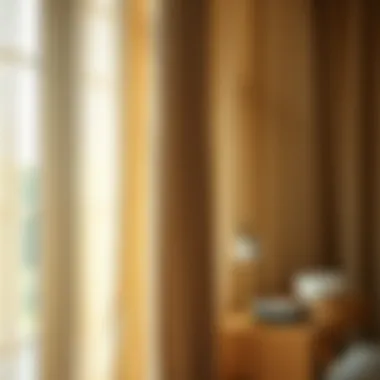

Intro
In the realm of interior design, drapery plays an essential role—transforming not just the aesthetic of a room but also its functionality. 104 inch drapery panels stand out for their length and versatility, making them a preferred choice for many homeowners and designers alike. While it may seem like just fabric hanging by a rod, these panels contribute significantly to the ambiance and style of a space. This article navigates through their importance, exploring various dimensions from styles and materials to installation methods and maintenance tips.
Furniture Design Trends
Even in the landscape of drapery, understanding current furniture design trends is crucial. As we see a shift towards minimalistic and airy environments, the choice of drapery evolves alongside it.
Current Trends in Furniture Design
Modern design leans towards sustainability and functionality. Natural materials are taking a front seat, so expect to see fabrics made from organic cotton or linen more often. These materials not only look great, but they also contribute to an eco-friendly home. Pairing 104 inch drapery panels with wooden or rattan furniture can create a harmony between softness and the ruggedness of nature. Subtle colors and patterns—think muted tones or light stripes—are favored, following the trend of simplicity and understated elegance.
"The right drapery can elevate both function and flair in spaces designed for both work and relaxation."
Influential Designers to Follow
To keep your finger on the pulse of design trends, look for inspiration from contemporary designers. Names like Kelly Wearstler and Studio McGee are rethinking spaces, often incorporating oversized drapes to enhance room height and drama. Keep an eye on their work for ideas that could translate into your own projects or personal spaces.
Practical Tips for Drapery Selection
Choosing the right drapery involves more than just selecting a pretty pattern. It's about making smart choices that complement your space.
Choosing the Right Materials
Selecting the fabric of 104 inch drapery panels is paramount. Heavier materials like velvet can add luxury and warmth, perfect for cooler climates. Conversely, lighter fabrics such as sheer linen offer a breezy feel that can open up a room and allow natural light to filter through. Don’t forget to consider the cleaning and maintenance; some fabrics may require professional cleaning, while others can be easily thrown in the wash.
Maximizing Space with Smart Drapery Choices
When it comes to hanging those long panels, placement matters. Positioning drapery rods close to the ceiling can make ceilings appear higher, creating an illusion of more space. Consider floor-length hems, which can add an air of sophistication while also effectively blocking out light and drafts.
A well thought out combination of drapery and furniture not only enhances the visual appeal of a room but also allows for practical solutions to arise, making every inch of space work to your advantage.
An Intro to Drapery
Drapery is far more than a mere piece of fabric hanging by the window; it plays a pivotal role in setting the mood and tone of an entire space. With the right drapery, any room can transform from ordinary to extraordinary. In this article, we delve into the world of 104-inch drapery panels, shedding light on their importance in modern home design. They are a versatile choice that can accentuate height and give a sense of sophistication and elegance, acting as both functional and aesthetic elements in interior decor.
In considering drapery, it's essential to grasp not only what makes it visually appealing but also what benefits it can bring to a room. For instance, the right drapery can improve energy efficiency, provide privacy, and even control the amount of natural light that enters your living space. Homeowners and decorators alike must weigh these factors carefully, especially given the wide range of styles, materials, and lengths available.
This article will guide you through understanding the ins and outs of drapery, starting from the specific nuances of 104-inch panels, their applications, to practical insights for selection and maintenance. Each section aims to enrich your knowledge and perhaps spark a little inspiration for your own decorating endeavors.
The Role of Drapery in Interior Design
Drapery serves multiple roles in interior design, acting as a crucial element that can make or break the overall aesthetic of a space. The right drapery can highlight architectural features, frame picturesque views, or even add layers to a room’s design. With the height that 104-inch panels provide, they draw the eye upward, creating an illusion of taller ceilings. This can be incredibly effective in rooms that tend to feel cramped or low, almost as if you are opening up a can of worms and letting in freshness and airiness.
Moreover, the choice of fabric can significantly impact a room’s acoustics, warmth, and style. Heavier materials like velvet can create a cozy, intimate atmosphere, while lighter fabrics like sheer linen allow sunlight to filter through, casting a soft glow. Homeowners often find themselves torn between the aesthetics and functionality of drapery, but with careful consideration, one can find a beautiful balance that satisfies both.
Understanding Different Lengths
When it comes to drapery, understanding the various lengths is paramount to achieving the desired visual effect. Drapery length can vary widely, with options like 84 inches, 96 inches, and of course, the more imposing 104 inches. The choice of length not only affects how drapery interacts with a room but can also change the proportion of the elements within that space.
104-inch drapery panels are often chosen for their ability to extend beyond standard window heights, making them ideal for spaces with high ceilings or larger window frames. The longer length can add drama and a sense of luxury to any interior. These panels are particularly favorable for floor-to-ceiling applications, where they can billow elegantly, providing an almost theatrical effect.
In summary, understanding the importance of drapery and its many facets, such as its role in design and the implications of length, is crucial for anyone wanting to enhance their living spaces effectively.
Understanding Inch Drapery Panels
When it comes to drapery, size matters. The 104-inch drapery panels stand out in the realm of interior decor, making a significant impact on style and functionality. These panels not only serve to frame windows but also play a pivotal role in enhancing the overall ambiance of a space. Their length often translates into a sense of grandeur and elegance, making them a preferred choice for homeowners and designers alike.
What Defines a Inch Length?
The designation of 104 inches pertains to the actual length of the drapery from the top of the heading to the bottom of the fabric. This measurement is ideal for spaces with high ceilings or larger windows, as it allows for optimal coverage and aesthetic appeal. Drapery panels of this length are typically used in combination with long curtain rods, enhancing the visual height of a room.
One key aspect of these panels is how they interact with the architecture around them. For example, a span of 104 inches lets the drapes reach various points of installation, from just above the window frame to the ceiling. This versatility helps achieve diverse looks, whether opting for a more casual, relaxed style or a dramatic, formal appearance.
Here’s a quick summary of a few important points about 104 inch drapery panels:
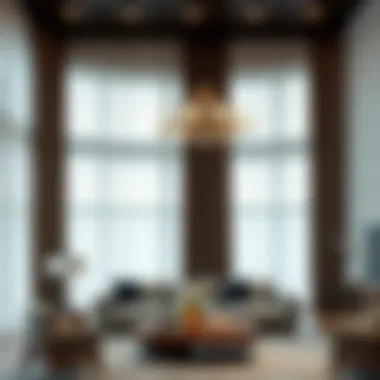
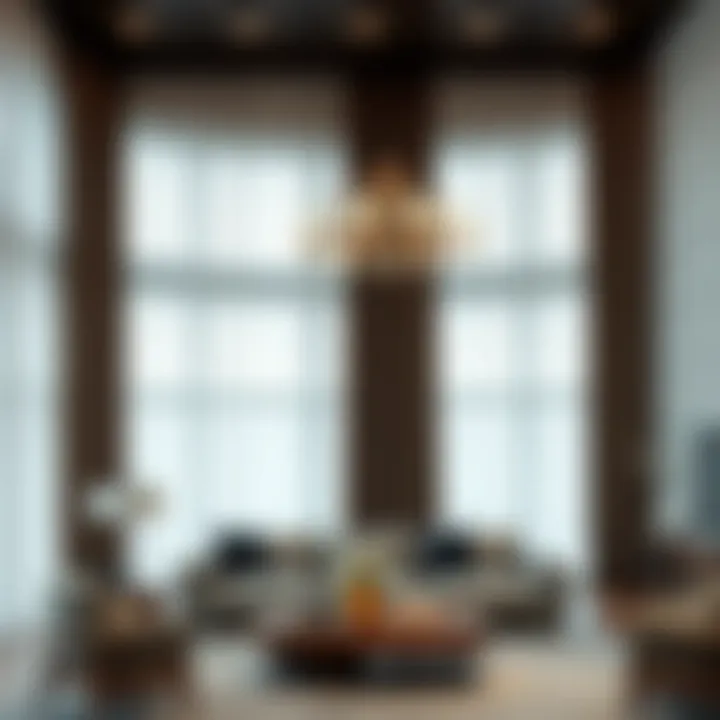
- Height enhancement: Helps elongate the perceived height of a room.
- Versatility in installation: Applicable for both aesthetic and functional installations.
- Visual impact: Brings a sense of elegance and formality to any space.
Common Uses in Home Decor
104 inch drapery panels find their place across a multitude of settings, proving their worth not only in functionality but also in beauty. Here are some common applications:
- Living Rooms: Often, these panels grace living areas, draping elegantly beside large windows or sliding glass doors. They add to a cozy yet sophisticated vibe, allowing for natural light while maintaining privacy when needed.
- Dining Areas: In dining spaces, they can create a classy ambiance, especially during evening dinners. The long drapery panels can soften ambient light and add warmth, making it all the more inviting for guests.
- Bedrooms: When it comes to achieving a restful atmosphere, 104-inch panels can blackout sunlight and enhance sleep quality, particularly when made from thicker materials like velvet or lined fabrics.
- Open Spaces: For lofts or open-concept homes, these panels can be utilized to create visual divisions between areas while still allowing light flow. This method preserves the airy feel of a space without fully isolating one area from another.
Materials and Fabrics for Drapery
Choosing the right materials and fabrics for drapery is much more than just picking what looks pretty. It's about understanding the fabric’s impact on style, functionality, and durability. Whether you're jazzing up a cozy living room or softening the harsh lines of a modern kitchen, the choice of fabric plays a pivotal role in the overall effect. Here’s a deeper look at various fabrics and their specific traits that make them suitable for drapery panels.
Popular Fabrics for Drapery Panels
Polyester
Polyester is like that reliable friend who shows up right when you need them. It’s a cost-effective choice that blends durability with a touch of style. One big selling point of polyester is its resistance to fading, shrinking, and wrinkling. This makes it a top pick for areas that see a lot of sunlight or where children and pets are running about.
One of the unique features of polyester is its ability to mimic the look of other fabrics, such as silk or linen. This allows for a high-end appearance without breaking the bank, making it a practical option for modern homes. However, beware of its breathability, or lack thereof; it doesn’t let air circulate too well, which might cause a bit of stuffiness in warmer climates.
Silk
Silk has its fans, and for good reason. It's often viewed as the pinnacle of luxury, elevating any space to a realm of refinement. The soft touch and beautiful luster can make a room feel more elegant in just an instant. Silk drapes elegantly, creating soft folds and a timeless feel that many seek.
However, there’s a flip side to this shimmering beauty. Silk is less forgiving when it comes to maintenance; it's more susceptible to damage from sunlight and can fade over time. This fabric demands a little extra care, as cleaning may require professional help, making it a less practical choice for high-traffic areas.
Linen
Linen tells a story of effortless charm and breezy vibes. Its texture offers a unique, slightly wrinkled appearance that adds character to drapery. Linen is known for its excellent breathability, which keeps spaces feeling cool and fresh, ideal for achieving a relaxed atmosphere.
That said, linen is not without challenges. It can be susceptible to staining and, while it’s more durable than silk, it does require regular upkeep to maintain its appearance. Still, when you want to infuse lightness and freshness into a room, linen is a go-to choice.
Velvet
When it comes to dramatic flair, nothing quite competes with velvet. This fabric has a luxurious feel that practically begs for attention. It not only acts as a thermal insulator, helping regulate temperatures but also gives off a rich, sophisticated vibe. Velvet curtains can transform a simple space into a regal palace.
However, keep an eye on maintenance with velvet. It can attract dust and pet hair faster than you can say "cleaning day." Additionally, it tends to be heavier, making installation require some planning. Still, the rewards of using velvet in drapery are undeniable, adding depth and warmth to any decor.
Choosing the Right Material
So, how does one sift through these options to find the fabric that aligns with their vision? Consider the ambiance you want to create, the functional demands of the space, and the level of maintenance you’re willing to commit to. Take fabric swatches, feel them in your hands, and imagine them paired with your existing decor.
Remember: Sometimes it's not just about what looks good; functionality and durability are equally important to ensure your drapery meets your lifestyle needs. Choosing the right fabric will enhance not only the beauty of your space but also its practicality.
Style Considerations
The selection of drapery styles is not merely a matter of aesthetics; it encompasses functionality, mood enhancement, and even the illusion of space within a room. Understanding the nuances of different styles ensures that homeowners can tailor their choices to fit both their functional needs and their design aspirations. Moreover, the right style can significantly influence the overall atmosphere, whether it be a cozy den or an elegant dining room.
When considering styles, homeowners should keep in mind how these choices reflect personal taste and complement existing decor. A drapery's style can contribute to a room’s cohesion or disrupt its balance and flow. This highlights the importance of being thoughtful about what style to choose.
Different Styles of Drapery Panels
Rod Pocket
Rod pocket drapery panels are distinguished by their simple design, wherein the fabric is sewn onto a channel at the top, allowing the curtain rod to slip through. This style is a classic choice, praised for its ease of installation and minimalistic look. A key characteristic of rod pocket panels is their soft, gathered appearance, which adds a touch of elegance to any window.
They are often favored in casual settings or traditional homes, contributing a sense of warmth and comfort. On the downside, they may not be the best option for spaces requiring frequent opening and closing, as the fabric can be somewhat restrictive. For example, in a bustling kitchen, one might find that grommet-style panels offer more flexibility.
Grommet
Grommet drapery panels feature large metal rings at the top, through which the curtain rod passes. This design provides a modern, sleek look that appeals to contemporary interior styles. One major benefit of choosing grommet panels is that they allow for smooth and effortless movement, making them ideal for areas where light control and easy access are priorities.
Additionally, their structured form creates a clean line that can enhance modern decor. However, their style may clash with more traditional or rustic interiors, as they can feel a bit too industrial.
Pleated


Pleated drapery panels are known for their tailored appearance, featuring fabric that is folded in crisp lines. This style often exudes sophistication and works tremendously well in formal settings. The main advantage of pleated panels is their ability to enhance the height of a room, making ceilings appear taller.
They also offer various pleat styles, such as pinch pleats and goblet pleats, allowing homeowners to customize their drapery to fit their mood. However, installation can be more intricate compared to simpler styles, requiring additional hardware and planning.
Tab Top
Tab top panels are a lovely blend of casual and chic. The fabric hangs from loops sewn into the top, creating a relaxed, laid-back feel. This style is popular in coastal or country-themed decorating schemes due to its lighthearted vibe.
A significant advantage of tab top drapery is the ease of installation; homeowners can often put them up without extensive tools. However, tab tops may limit the choice of rods to those that better suit the fabric, and may not translate well in very formal settings where a polished look is paramount.
How Style Influences Space Perception
The way drapery is styled can significantly alter how space is perceived. When homeowners choose high ceilings or wide windows, longer drapery panels can draw the eye upward, creating an illusion of greater height. Conversely, shorter drapes might make a room feel more confined, so it’s crucial to gauge how the style interacts with the overall architecture.
The choice of color and patterns in these styles also plays a fundamental role. Bright colors can invigorate a space, while darker tones may induce a sense of coziness but can also feel oppressive in small rooms.
In all, selecting drapery styles should be a thoughtful and intentional process, one that reflects not only practical needs but also the essence of the space.
Installation and Hanging Methods
When it comes to drapery, the way panels are installed and hung can make or break the overall aesthetic and functionality of the space. Installation isn't just about hanging fabric; it's about creating a seamless look that enhances the room's character. Drapery panels, especially those as lengthy as 104 inches, can dramatically alter a room's perception. Proper installation ensures that these panels fall gracefully to the floor, adding an element of elegance, and framing windows in a way that invites natural light while providing privacy.
A well-thought-out installation process not only boosts the visual appeal but also extends the lifespan of the drapery. Droopy or ill-fitted panels can contribute to an unkempt appearance, clashing with the sophisticated design one may seek. It's crucial to pay attention even to the most minor details during this stage.
Preparing for Installation
Preparation is key. Before embarking on the installation journey, there are several steps worth mentioning. Measure, measure, measure! Inaccurate measurements can lead to a cascade of issues, including panels that are either too long or too short. To avoid such mishaps, consider the following:
- Measure the Width and Height: Always record the dimensions from multiple points to account for any discrepancies in window framing.
- Choose the Right Hardware: Support for your drapery comes from hardware such as rods, brackets, and rings. Ensure these pieces can bear the weight of the chosen fabric.
- Select Your Mounting Style: Decide whether you’re going for a mounted rod above the window frame or outside mounting that can enhance the overall height, creating an illusion of larger windows.
When you've got all the tools ready, including a drill, level, measuring tape, and perhaps a stud finder, you're set to start. Gather your drapery panels and peruse the instructions specific to your hardware, if applicable. Every detail counts here; even the smallest oversight can lead to lopsided curtains.
Techniques for Hanging Drapery Panels
Hanging 104-inch drapery panels offers an opportunity to display both style and practicality. How you choose to hang them can significantly influence the room's atmosphere.
- Rod Pocket: This classic style features a sewn-in pocket at the top, allowing a rod to slide through. It's simple to set up and creates soft, billowy folds.
- Grommet Panels: Featuring metal rings sewn into the top of the fabric, grommet panels slide easily along the rod. This method offers a modern look, ideal for a clean aesthetic.
- Pleated Drapery: A sophisticated choice, pleated drapes provide a tailored appearance. They require a certain skill to hang, as you’ll want equal spacing to maintain a uniform look.
- Tab Top: Tabs sewn at the top create a casual, laid-back vibe. Simple and stylish, they require on average more distance from the top of the window as they sit on the rod at roughly the fabric's width.
Once the chosen technique is decided, simply slide the panels onto the rod and adjust accordingly. Weight can be your best friend here, helping the fabric settle evenly. A key advice is to step back and assess from different angles, ensuring you get a visually pleasing result. Remember, drapery can act as an accent; making sure it’s done right can elevate your space to unexpected heights.
“The details are not the details. They make the design.” - Charles Eames
Maintaining Your Drapery Panels
The upkeep of drapery panels is akin to tending a delicate garden; neglect can lead to a landscape in disarray. Maintaining your 104 inch drapery panels is not just about keeping them looking pristine. It's about preserving their functionality and enhancing your overall interior design. Well-maintained drapery panels can act as a visually appealing frame to your windows, providing warmth, color, and a touch of sophistication. Conversely, poorly maintained panels can detract from the aesthetic of your space and reduce their effectiveness in regulating light and privacy.
Regular attention to your drapery extends its lifespan, saving homeowners from the hassle and expense of replacements. Dust and dirt can accumulate over time, gradually dulling the fabric's brilliance and potentially affecting its structural integrity. Hence, understanding the intricacies of care is essential for any homeowner or decorator eager to keep their investments looking their best.
Here, we will explore the necessary cleaning and care instructions, as well as the handling of fading and wear, ensuring that your drapery panels not only enhance your space but remain functional over the years.
Cleaning and Care Instructions
To keep your drapery panels in tip-top shape, regular cleaning should be part of your routine. The method you choose largely depends on the fabric type, so it’s wise to refer to the care label first. Here are common guidelines:
- Vacuuming: Use a soft brush attachment on your vacuum cleaner to remove dust and crumbs without damaging the fabric. Do this monthly or more frequently in high-traffic areas.
- Spot Cleaning: For unexpected stains, tackle them immediately using a damp cloth and a mild detergent. Never rub too hard, as that can create a bigger mess. Gently blot the area instead.
- Machine Washing: Only if the care label permits, use a gentle cycle in cold water with mild detergent. Avoid mixing with heavier items to protect the fabric.
- Dry Cleaning: Depending on the material, it may be best to take them to a professional cleaner. This is especially true for fabrics like silk or intricate designs.
"Regular cleaning not only refreshes the look but also helps to maintain the fabric's texture and appearance."
When washing, also refrain from wringing or twisting the fabric to remove excess water – simply allow them to hang dry. If ironing is necessary, turn to a low heat setting and use a cloth barrier to prevent direct contact.
Dealing with Fading and Wear
Fading and wear are inevitable aspects of any fabric’s life cycle, particularly for drapery panels that face a substantial amount of sunlight. However, there are measures you can take to manage and minimize these effects. To help maintain your drapery’s vibrancy:
- Use Liners: Consider attaching a blackout or sheer liner to your panels. Not only does this enhance privacy, but it also offers a safeguard against harmful UV rays.
- Rotate Panels: If your drapery rod allows, periodically switching the position of your panels can help distribute the wear more evenly.
- Regular Repositioning: Even a little adjustment in how the curtains hang can change where the sun hits, ultimately prolonging the material’s lifespan.
- Consider Window Treatments: Shutters, shades, or blinds can serve as an additional barrier against sunlight, thus reducing the strain on your drappery.
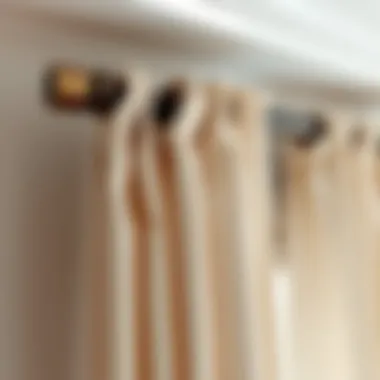
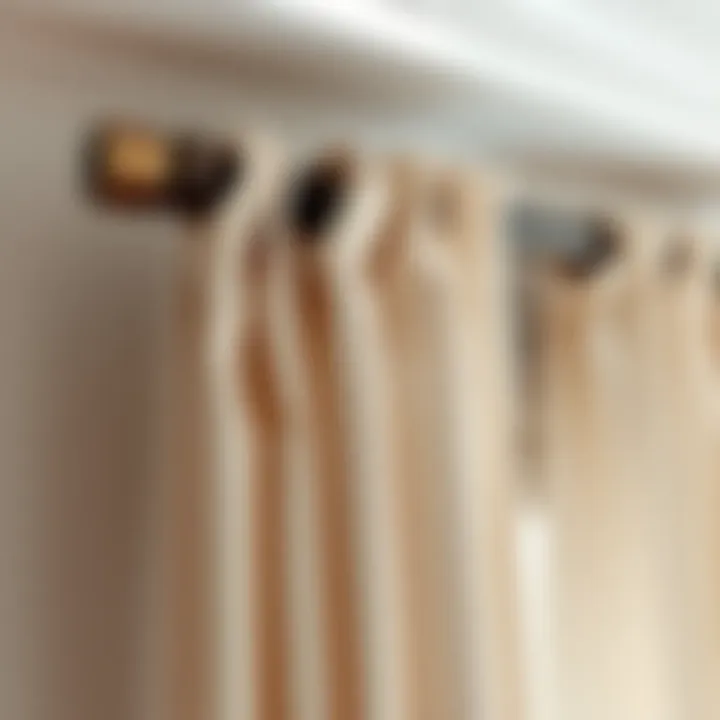
By incorporating these practical strategies, homeowners can ensure that their 104 inch drapery panels not only remain beautiful but also functional, adapting to changing decor needs while standing the test of time.
The Impact of Color on Mood and Space
When it comes to home decor, color is much more than just a visual element; it's a significant player in the emotional tone of a room. The right choice of color can inspire feelings of warmth, calmness, or even creativity. On the flip side, the wrong hue might lead to tension or discomfort. This is particularly true when considering drapery options, such as 104-inch panels that are not only functional but can also be pivotal in setting a room's mood. Thus, understanding the impact of color in your choice of drapery panels can elevate a space from merely functional to truly transformative.
Consider this: a softly colored drapery can instill a sense of tranquility, while a bold, vivid shade might inject energy into the living space. The influence of color transcends the visual, shaping our emotional responses and influencing how we interact with the environment around us. For homeowners and designers, this is an opportunity to curate an atmosphere that resonates with desired feelings.
Choosing Color Schemes
Selecting a color scheme is often the first step in creating a cohesive design narrative within a space. Here are a few strategies that can help homeowners and decorators alike in choosing the right color for 104-inch drapery panels:
- Complement Your Palette: Identify the dominant colors already present in the room, including walls, furniture, and accents. Neutral draperies may seamlessly blend, while deeper shades can provide dramatic contrast.
- Mood and Functionality: Consider the room's purpose. For a serene bedroom, opt for soft blues or greens; for an energetic kitchen or family room, warming yellows or vibrant reds might be more appealing.
- Textures and Patterns: Sometimes, a single color can fall flat. Using textured fabrics or diverse patterns can enhance the visual interest while maintaining a color balance.
By contemplating these guidelines, one can make informed decisions that will enhance both the function and form of space.
Psychological Effects of Color in Drapery
Colors evoke specific psychological responses that can greatly affect our mood and perception. For instance:
- Blue: Often associated with calmness and serenity, blue drapery can create a peaceful retreat, making it ideal for bedrooms and relaxation spaces.
- Red: Known for stimulating energy and conversation, red can make a room feel lively, making it a prime choice for social areas. However, use sparingly to avoid overwhelming the space.
- Green: Symbolizing nature and balance, green tones can promote well-being and tranquility, suitable for almost any setting.
- Yellow: A cheerful color that brings warmth and optimism. Drapes in this shade can contribute to an uplifting atmosphere, particularly in smaller spaces that may lack natural light.
"Colors, like features, follow the changes of the emotions." – Pablo Picasso
In summary, the psychological connotations attached to colors are pivotal in heightening the overall aesthetic and emotional effectiveness of drapery. When you integrate thoughtful choices of hue in drapery panels, such as 104-inch options, you’re not just dressing windows; you’re sewing your personal narrative into the very fabric of your home.
For more insights into color theory and its implications in design, consider exploring resources such as Color Matters or The Psychology of Color.
Choosing colors wisely for drapery can warmly wrap a space in emotion, making the home feel more welcoming or energizing as needed. The next time you contemplate drapery panels for your interiors, remember—each color speaks a language all its own.
Customization Options for Drapery
Customization presents itself as a vital facet in the realm of drapery, allowing homeowners and designers alike to carve out a unique visual narrative within their spaces. It’s not merely about choosing a fabric or color; it’s about crafting a tailored experience that echoes your personality, preferences, and the specific needs of your environment. In the context of 104 inch drapery panels, the urgency of customization rises, addressing both aesthetic desires and functional requirements. Every individual space communicates a different mood and customization brings that expression to life.
Being able to tailor drapery panels means that one can adapt them to varying ceiling heights, room dimensions, and window styles. For instance, in rooms with lofty ceilings, opting for longer panels can enhance that vertical feel, heightening the sense of space. Similarly, in smaller rooms, careful selection of materials, patterns, and light-filtering options can either snugly embrace the intimacy of the space or create an illusion of expansiveness. This fine-tuning is one of the many benefits custom drapery offers.
Tailoring Drapery Panels for Your Space
When it comes to tailoring drapery panels, it’s essential to start with precise measurements. Accurate dimensions not only guide fabric choices but also dictate how the drapes will behave within the context of the room. Here are some factors to think about when measuring:
- Ceiling Height: Consider if you want the drapery to graze the floor or float above it. This can radically change the room's feel.
- Window Size: If your windows are larger than average, bespoke drapery can ensure that they are framed beautifully and proportionately.
- Style of Room: The choice of tailoring also hinges on the overall aesthetic—be it modern, traditional, or eclectic. Custom drapery can solidify that theme.
Ultimately, a carefully tailored drapery panel that fits snugly can significantly influence the harmony and balance of the space. Each fold, each pleat, communicates a story about intention and design.
Incorporating Personal Touches
Beyond the technicalities of fitting and style, incorporating personal touches into drapery panels allows for a deeper connection to the space. This personalization often transforms mere fabric into a statement piece. Some ideas include:
- Unique Fabrics: Selecting fabrics from unique sources, such as handwoven textiles or reclaimed materials, brings character.
- Custom Prints: Opt for a printed fabric that resonates with personal sentiments or memories, making each glance a gentle reminder of cherished moments.
- Details and Accents: Add trimmings, such as beaded edges or decorative tassels, to infuse vibrancy and texture.
These elements, brought together thoughtfully, offer a fresh wave of creativity. They not only enhance the visual appeal but also create a strong narrative, turning each room into a personal sanctuary.
"Customization turns ordinary into extraordinary! It reflects the essence of who you are within your own home."
Adding these personalized nuances elevates 104 inch drapery panels beyond mere functionality, making them integral parts of your home’s story. By thoughtfully considering customization options, one can curate a living space that is truly unique and in harmony with their lifestyle.
Finale
In this article, we have explored the multifaceted world of 104 inch drapery panels, a staple in contemporary home design that combines style with practicality. Understanding their role not only enhances a space aesthetically but also serves crucial functional purposes. These long panels can create a sense of height and elegance in a room, making them particularly suitable for spaces with tall ceilings or grand windows. The ability to control light and privacy cannot be understated, and drapery plays an undeniable role in setting the ambiance of a space.
Recap of Key Points
As we draw this discussion to a close, let’s recap some key takeaways:
- Drapery’s Functionality: 104 inch panels are ideal for tall windows, providing both coverage and elegance. They can transform a bare wall into a striking focal point.
- Material Matters: The choice of fabric directly affects the drapery's functionality and appearance. Options vary from luxurious silk to more casual linen, each serving different design goals.
- Installation Techniques: Proper hanging methods can profoundly influence the drapery’s visual impact. Knowing how to best install these panels can make a world of difference.
- Customization Opportunities: Tailoring drapery to fit personal style is essential. Whether it’s choosing the right color, fabric, or even additional embellishments, customization can elevate the standard look to something unique.
- Future Trends: As we look forward, the trends in drapery design continue to shift towards eco-friendly materials and smart systems, integrating technology into our interiors.
The Future of Drapery Design
Looking ahead, the future of drapery design seems bright and innovative. Increasingly, homeowners and designers are shifting towards
- Sustainable Materials: The demand for environmentally friendly fabrics is rising, as consumers become more conscious of their ecological footprint. Materials like organic cotton and recycled polyester are gaining popularity.
- Smart Technologies: Automation in home design is also making its way into drapery. Motorized curtains operated via smartphone apps or voice commands are becoming common, blending convenience with sleek design.
- Bespoke Solutions: As personalization becomes more prevalent, we can expect programs allowing consumers to customize drapery dimensions and styles online, ensuring their preferences are entirely reflected in their decor.
In wrapping up this exploration, one can appreciate how multifaceted drapery panels are on many levels, from their functional features to the subtleties of design. Engaging with this topic breeds a deeper understanding of how even such a seemingly simple element can wield substantial influence over home interiors.



